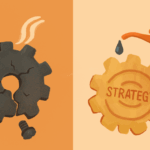The year was 1994. I was sitting on the couch in my parents’ family room, watching DuckTales and eating an after-school snack of Cheez-Its and Shasta, when my dad called up to me from our basement.
“Jaime! Come down here!”
His voice was tinged with a mixture of excitement and urgency. I hurried down the stairs and found him sitting at our old, 1950s-style metal desk, his eyes lit up with excitement. On the computer monitor in front of him was a white screen with plain blank text – the contents of which have been lost to time. In the corner was a logo: Netscape.
“I’m on a computer in Texas!” my dad exclaimed. I had no idea what was happening on the screen, but his enthusiasm was contagious. In retrospect, the echo of my father’s voice calling me to witness the Internet’s nascent stages was a foreshadowing of my own journey with technology.
Born in 1977, I am one of the few kids from that era who cannot remember a time before I had access to a computer. My dad was the earliest of adopters, spending the equivalent of $7,700 on an Apple II Plus in 1980. I followed closely in his footsteps, designing a family newsletter on that same computer at age 8, hand coding my first website in 1995, buying an early Palm Pilot, snapping up an early Google Plus account, and embracing QR codes before they were cool.
I don’t think I understood in 1994 how momentous that moment was. What I was witnessing was the birth of the publicly available Internet — perhaps the most life-changing invention of the past 50 years. Although I had no idea that we would come to carry the world in our pockets on tiny computers that could also make calls, I got chills. I feel those same chills today when I think about the possibilities of generative AI.
With tools like ChatGPT, Jasper, Bard and others crashing into the mainstream during the past 12 months, marketers have access to powerful tools that can help us be more effective and efficient. Among the benefits are the following:
- content creation in the blink of an eye;
- efficiency gains on administrative tasks;
- a brainstorming partner that never gets tired; and
- the ability to spread our limited resources further.
But not everyone shares my enthusiasm for new technology. There are obstacles to widespread adoption in higher education marketing offices.
- Lack of awareness of the tools
- Technical intimidation
- Skepticism about AI’s abilities
- Preference for human interaction
- Fear of obsolescence
- Limited training
- Rapid evolution of the technology
So how do you overcome these hurdles and build a culture that supports the exploration of generative AI? I have approached this challenge by tackling it three ways.

1. Building Awareness
While I am a technology nerd, I understood that not everyone geeks out over new tech the way I do. As recently as September, some folks in my team hadn’t heard of ChatGPT. Others were aware of it but hadn’t yet tried it. And others had tried it but hadn’t cracked the code for prompt engineering.
With that in mind, in one of our all-hands staff meetings, I presented a 30-minute presentation on ChatGPT and the ways that I use it to create efficiency and build bandwidth in my day. There were definitely skeptics in the room, but others grew excited and saw the possibilities immediately. I encouraged them to consider playing with ChatGPT and exploring its potential uses.
2. Identifying Early Adopters
After that introduction, I asked each of my directors to assign one person in their department to our internal AI Exploration Team. This group is charged with spending at least 30 minutes a week exploring the latest developments, use cases and advancements in generative AI; learning about new tools, platforms and technologies; reflecting on how AI tools could be applied, adapted or piloted within our division; and documenting insights, ideas or potential applications.
We created a channel in Slack for the whole team and asked the AI Exploration Team to share ideas and insights as they learned more. The channel has been abuzz with activity as people have shared what they have learned during their exploration. We also allocate time during our divisional meetings to share and discuss insights. The goal is to move from exploration to adoption as we seek opportunities to pilot technologies that streamline work and create more effective content.

3. Expanding the Circle
Encouraging AI adoption among our division was important, but expanding its usage across campus is critical. To start, I partnered with Dave Hunt, creative director for ODUGlobal, to offer a workshop to all campus communicators. Approximately 35 people attended “Generative AI for Marketing Professionals,” which included not just an introduction but also a deep dive into how to harness ChatGPT for more complicated activities.
Much like our approach with our internal team, we created a Teams site so the campus community could share their ideas and insights with others. AI is now a standing item on our Campus Communicators meeting agendas, encouraging us to keep the tools top of mind as we work. The goal is to ensure that all marketers on campus have the awareness, access and skillsets to harness these tools to their maximum potential.
Generative AI, much like the internet in 1994, stands at the threshold of becoming a transformative force in the realm of marketing and beyond. Despite the challenges that lie ahead — resistance to change, skepticism and the learning curve — I believe it is essential to foster a culture that not only adapts to but also embraces these tools.
The initiatives to build awareness, identify adopters and expand the circle of engagement within the larger marketing community on our campus are more than just strategies; they are the necessary steps toward cultivating a future-ready mindset. When people are given the opportunity to explore and understand new tools like ChatGPT, they often move from skepticism to belief in their potential.
The future is undeniably digital, and generative AI is a significant part of that future. It presents an opportunity to amplify our capabilities, to extend our creative and operational reach and to reimagine the ways in which we connect with our audiences. The enthusiasm that once gripped me as a child — and the chills I felt at the sight of my dad connecting to a computer in Texas — mirror the excitement I feel today as we stand on the brink of another digital revolution.
The task ahead is not without its hurdles, but the rewards promise to be as boundless as the internet once seemed in that dimly lit basement. For those of us who lead the charge in integrating generative AI into our practices, the journey ahead is as thrilling as it is imperative. In the end, the vision is not just to keep pace with change but to drive it, harnessing the full potential of AI to illuminate new paths for innovation and connection.







